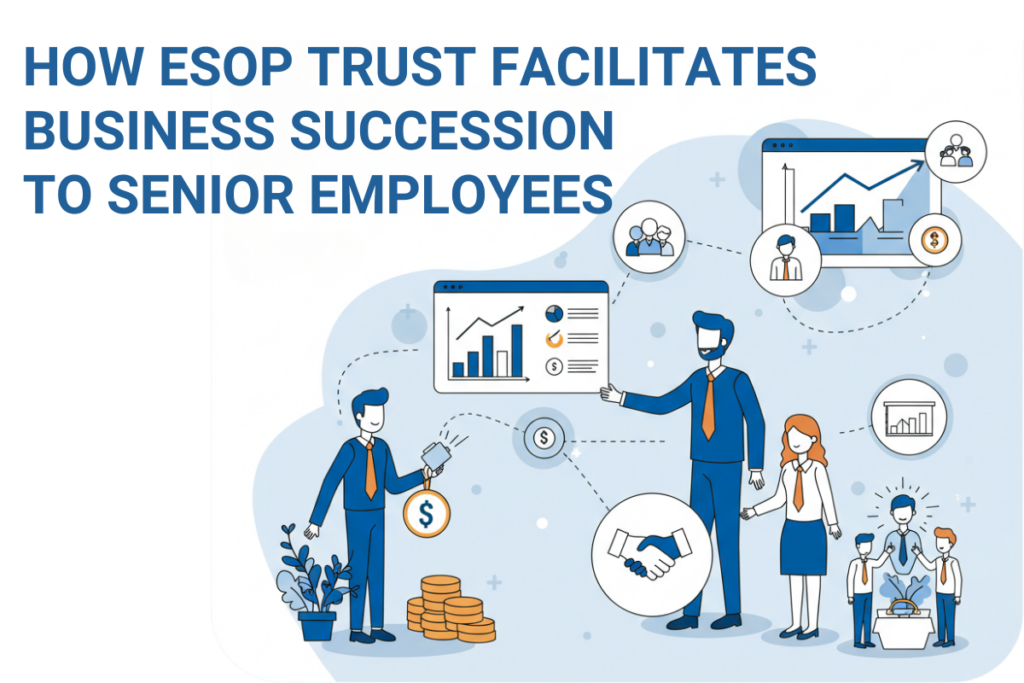One of our clients, Ravi has grown the company from a small start-up to a mid-sized tech company, but as he approaches retirement, he wants success for his business, but his fear is ownership distribution without commitment.
Ravi has a strong leadership team, but he needs a mechanism that will incentivize key employees to think beyond just profit-making. He wants to create a culture of ownership where employees focus on building the sustainable business and contributing to the company’s future assets. To achieve this, Ravi decides to implement an Employee Stock Option Plan (ESOP) with a unique twist: he will route the plan through an ESOP trust.
How the ESOP Trust Route Benefits the Owners (like Ravi Gupta)?
Here’s a deeper look at how the ESOP trust route to facilitate succession owners like Ravi, through specific examples of how it works: 1. Control and Flexibility Over Ownership Transfer
An ESOP trust gives owners like Ravi the ability to retain control over who becomes a shareholder and when they acquire ownership. By issuing conditional ESOPs tied to specific performance milestones, Ravi can ensure that employees do not immediately gain ownership. Only after meeting certain conditions do, they receive shares, ensuring that ownership is transferred to those who align with the company’s long-term strategic goals.
How This Benefits the Owner:
- Ravi can ensure that only high-performing employees who contribute to the company’s success, maintaining control over the future direction of the company.
- The gradual vesting ensures employees are committed for the long term, which reduces turnover and incentivizes consistent performance.
- The ESOP trust route not only benefits Ravi as being the owner giving him control and flexibility over ownership transfer but also benefits the employees as the deserving one gets the ownership rights through ESOP trust.
Example:
Ravi offers Neha, a senior sales manager, a conditional stock option as part of the ESOP trust. The conditions are:
- Building strong sales funnel to get year on year x% growth.
- Opening new region with sales > x amount.
- Leading Two Major Product Launches.
If Neha meets these goals simultaneously, she will receive x% of the company. The equity will vest over time, further ensuring Neha stays committed to driving the company’s success.
By tying ownership to strategic business outcomes, Ravi maintains full control over who enjoys the ownership rights through ESOP trust and under what conditions, ensuring only the deserving employees benefit from ownership.
- Incentivizing the Ownership
An ESOP scheme allows Ravi to tie vesting conditions to both financial and non-financial metrics. This means employees are not only motivated to drive profits but are also incentivized to focus on building the sustainable business, expanding into new markets, and contributing to its long-term growth.
- Creating a Seamless Transition for Succession Planning
Ravi sees the ESOP trust as a key tool for succession planning. By gradually transferring ownership to key employees who demonstrate leadership potential, Ravi ensures that the next generation of leaders will be prepared to take over the company’s reins when he steps down. This gradual transfer of ownership not only helps protect his legacy but also ensures that future leaders are aligned with his values and the company’s goals. Also, appointing a Trustee from the board makes it easier for the owner to create seamless transition for succession planning through ESOP trust.
How This Benefits the Owner:
- Ravi can prepare a next-generation leadership team that is invested in the company’s success and well-being.
- The gradual transfer of ownership ensures that the transition is smooth and does not disrupt the company’s operations.
- Attracting and Retaining Top Talent
An ESOP trust is a powerful tool for attracting and retaining top talent, especially in competitive industries.
Conclusion:
By implementing an ESOP trust, Ravi Gupta gains the flexibility and control to ensure that ownership is transferred to the right people, who are motivated to focus on both short-term profitability and long-term company growth. Through specific performance milestones, brand-building initiatives, and succession planning, Ravi can ensure that his company remains in capable hands as he prepares for retirement. The ESOP trust route helps him incentivize top talent, retain key employees, and create a smooth leadership transition, all while aligning their efforts with the company’s long-term goals.
If you intend to take the next step in finding your business succession, let’s connect on Mail id: info@sncoglobal.com





